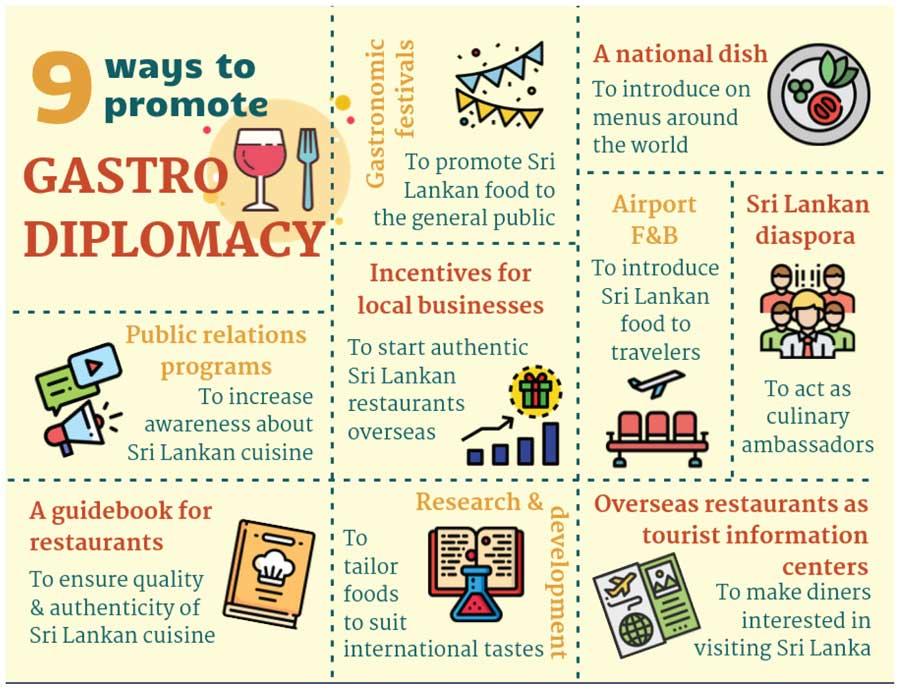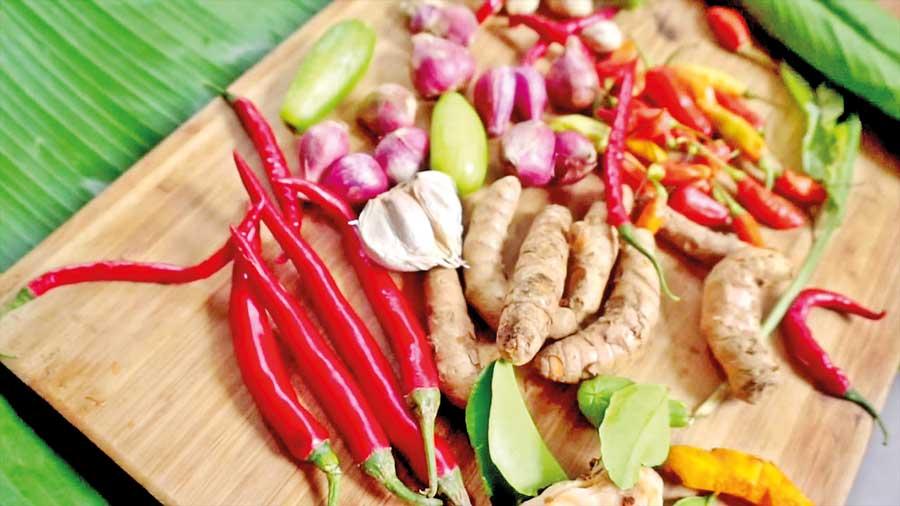The Easter Sunday terror attacks dealt a blow to the Sri Lankan tourism industry, the third largest source of foreign exchange in Sri Lanka. Thousands of tourists visiting Sri Lanka cut their holiday plans short and returned home, while many advance bookings were cancelled.
The Sri Lanka Tourism Promotion Bureau (SLTPB) estimates a 30 percent loss to the economy and over a year for the industry to return to its previous growth momentum. In addition to the SLTPB’s plans for a multi-country marketing plan — reportedly worth Rs.1.3 billion, all possible avenues to rebuild tourism stakeholder confidence must
be explored.
This policy brief will explore the potential of using gastrodiplomacy as a way to aid the recovery of Sri Lanka’s tourism sector and strengthen Sri Lanka’s brand identity through the promotion of food and culture. The brief will discuss how gastrodiplomacy as a national strategy has been adopted in other pioneering countries such as Thailand and lessons Sri Lanka can learn from such experiences. Finally, the brief will provide a few policy suggestions outlining some broad policy decisions and specific actions that Sri Lanka could consider to advance a successful gastrodiplomacy strategy.
What is gastrodiplomacy?
A key selling point of Sri Lanka as a tourist destination is its array of holiday experiences, all within a distance of a few hours. Although often overlooked as a prime tourist attraction, there is now a growing interest in Sri Lankan cuisine due to its unique features. Sri Lanka can leverage this interest to promote itself as a culinary destination and tap into the growing market of culinary tourism.
However, no country can place itself on the culinary map of the world overnight. It requires a long-term strategy and careful planning. In this regard, ‘gastrodiplomacy’ is an innovative approach that could be adopted to introduce Sri Lankan food globally. Such a strategy could potentially increase Sri Lanka’s export earnings, diversify its tourism sector and increase its cultural influence globally.
Gastrodiplomacy is a government’s practice of promoting national culinary heritage to “raise national brand awareness, encourage economic investment and trade and engage in a cultural and personal level with everyday diners”. It is “a form of public diplomacy that combines cultural diplomacy, culinary diplomacy and nation branding”.
While the concept of gastrodiplomacy is new, food has been used as a tool to achieve diplomatic goals throughout history. For example, in ancient Greece, public luncheons brought diplomatic corps together to discuss allegiances, conclude aggressions and ratify treaties.
Gastrodiplomacy is essentially a subfield of cultural public diplomacy and a tool of nation branding. Gastrodiplomacy programmes today aim to improve the national image by using a nation’s culinary culture as a means to change public perceptions and promote itself on the global stage.
While there are many ways for a nation to define and visualise its identity, food is a particularly effective one. Today, many countries have recognised the use of gastrodiplomacy in engaging foreign audiences and have devoted significant resources to fund formal campaigns.

Thailand: Pioneer and model for gastrodiplomacy
Thailand is unarguably the pioneer of modern-day gastrodiplomacy. Gastrodiplomacy in Thailand emerged in 2001 when the Thai government launched the public diplomacy campaign ‘Global Thai’ to promote its food and culinary culture to the world. The campaign aimed at increasing the number of Thai restaurants worldwide from 5,500 to 8,00 by 2005.
It was so successful, that by 2016, close to 15,000 Thai restaurants were established worldwide. As a result, today, Thai cuisine is immensely popular across the world. Estimates show that in the USA, there is one Thai restaurant to roughly every 55 Thai-Americans, a considerably high population-to-restaurant ratio compared to more sizable demographics. This is demonstrably true of Mexican-Americans, where only one restaurant exists for every 650
Mexican-Americans.
While bolstering the presence of Thai cuisine around the world, the campaign also aimed at increasing Thailand’s export and tourism revenues, creating a positive image of Thailand abroad and drawing attention away from negative stereotypes associated with Thailand’s sex tourism. As Thai food exploded in popularity, so did the interest in visiting Thailand. Since the launch of Global Thai in 2002, there has been a significant surge in tourist arrivals – from 10.8 million tourist arrivals in 2003 to 38.28 million
in 2018.
The exposure to Thai food is a driving factor for the high tourism numbers. A survey conducted by the Bangkok University Research Centre indicated that 63.3 percent of tourists are attracted primarily by Thai food. One-third of tourist spending in Thailand is on food and drinks.
Thailand’s success at executing gastrodiplomacy is largely due to the Thai government’s excellent conceptualisation and execution abroad. The strategies implemented were multi-fold, run by multiple national institutes but coordinated by the Department of Export Promotion (DEP) of the Commerce Ministry.
To attract potential investors, the DEP formulated three different ‘Master Restaurant’ prototypes. The prototypes comprised restaurant plans and menu options and were aimed at three different consumer markets and styles. They minimised an investor’s early operational costs, whilst guiding them to maintain quality standards and establish a strong and authentic Thai image.
Special finance schemes were offered by the Export-Import Bank of Thailand and other capital companies to Thai investors who intended to open Thai restaurants in foreign countries. The Small and Medium Enterprise Development Bank of Thailand offered infrastructure loans up to US $ 3 million for enterprises in the food industry, including foreign Thai restaurants.
The Thai government also provided special training for Thai chefs. The Skill Development Department of the Thai Labor Ministry offered cooking courses focused on theoretical and practical knowledge in Thai cooking, purchase of raw materials, storing, preservation, nutrition, work safety and basic English and restaurant administration.
The Public Health Ministry published a book in 2002 titled ‘A Manual for Thai Chefs Going Abroad’ with information about recruitment, training and local tastes. Thai cuisine was also promoted abroad by training Thai chefs to work overseas. New Zealand, for instance, issues a special ‘Thai Chefs Work Visa’, specifically for chefs from Thailand to promote Thai food. It allows qualified, experienced Thai chefs to work in New Zealand for up to three years, with an extension up to one year.
Crucially, the DEP matched Thai citizens with foreign investors interested in investing in Thai restaurants. It conducted research on local tastes and consumer behaviour around the world and sent representatives from Thai cooking institutes abroad to train chefs at foreign restaurants. Through embassies located worldwide, it organised various food festivals and cooking competitions.
As the number of overseas Thai restaurants grew, the government took measures to control standards and guarantee the authenticity of these restaurants. For this, the government awarded the ‘Thai Select’ label to authentic Thai restaurants. The ‘Thai Select’ or ‘Thai Select Premium’ certification recognises Thai restaurants that offer at least 60 percent authentic Thai food on their menus. This certification also indicates that these restaurants employ the authentic Thai cooking techniques and import ingredients from Thailand.
The certificates are awarded by the DEP to restaurants, which satisfy minimum requirements and are issued through Foreign Trade Promotion Offices and Thai embassies worldwide. As of today, there are close to 1,500 Thai Select restaurants listed on the official Thai Select website.
In subsequent years, several countries have followed the example of Thailand’s successful gastrodiplomacy campaign and started programmes to promote their own national cuisines and culinary cultures. For example, in 2010, Taiwan’s Economic Affairs Ministry funded a US $ 34.2 million four-year plan aimed at creating 50 international brands, 3,500 new restaurants and 10,000 jobs by end-2013.
The campaign was successful, as confirmed by the 2017 Survey Report on Visitors Expenditure and Trends in Taiwan by the Taiwan Tourism Bureau, in which 55 percent of respondents stated ‘gourmet food or delicious snacks’ as the most impressive feature of Taiwan, second only to ‘scenery’ (59 percent). Similarly, South Korea officially announced the ‘Global Hansik Campaign’ in 2008 with the objective of popularising Hansikor Korean cuisine.
Its Food, Agriculture, Forestry and Fisheries Ministry dedicated US $ 40 billion to increase the number of Korean restaurants overseas to 40,000 and make Hansikone of the world’s top five cuisines by 2017.
In a 2018 survey by the Korea Tourism Organisation, 71.3 percent of respondents listed ‘gourmet tours’ as a major tourist activity second to ‘shopping’ (92.5 percent). In the recent years, Malaysia, Japan, Peru, France, the USA and Nigeria have also adopted gastrodiplomacy strategies further proving the effectiveness of the concept.

Winning hearts through stomachs: Lessons for Sri Lanka
Sri Lanka has a long-established tourism brand but struggles with several negative images such as the 2004 tsunami, civil war and more recently the Easter Sunday attacks. Therefore, building a stronger and more cohesive national brand is vital for Sri Lanka at this stage of its development.
A strong brand is more resilient in the event of bad news—tourism in London, Paris and Bali bounced back quickly after terror attacks. Such a brand also enables local producers to charge a premium for their products relative to competitors—for example, Swiss chocolate, French wine or Colombian coffee.
This policy brief suggests that Sri Lanka should adopt a gastrodiplomacy campaign similar to Thailand to improve its national image, boost tourism and generate export revenue. Having a unique cuisine, Sri Lanka certainly has an unexplored potential to become the heart of gastrodiplomacy. Sri Lanka can look towards Thailand for best-practices to create a new national brand identity based on cuisine that is differentiated, relevant and credible.
Exploring Sri Lanka’s potential
Sri Lanka is home to a rich and diverse gastronomy that could be showcased around the world. Throughout history, contact with foreign traders, years of colonisation and a multicultural population has developed Sri Lankan food culture into a unique culinary heritage.
For example, the influence from the Portuguese, who introduced the use of chilli and culinary terms such as ‘temper’, the Dutch, who introduced breudher, frikkadel (meatballs) and lamprais, the Malays, who introduced watalappam, pilau and biryani and the influence from Sinhala, Tamil and Muslim cultures, have shaped local cuisine.
Sri Lankan food culture is also influenced by the island’s tropical climate, diverse topography and the availability of a staggering variety of fruits, vegetables and edible greens. Furthermore, the various annual religious and cultural festivals have also gifted traditional dishes such as kavum, kokis and aluwa prepared during the Sinhala and Tamil New Year and watalappam popular during the Eid season.
While Sri Lankan cuisine is yet to make its mark globally—as a cuisine that is on equal footing with its more popular Southeast Asian neighbours—Sri Lankan cuisine is on its way to being discovered as a serious global contender. Recently, BBC’s Good Food ranked Sri Lankan cuisine as the top food trend for 2019.
According to BBC Good Food, “[r]estaurants such as London’s Hoppers, mini chain The Coconut Tree…have put Sri Lankan food on the brink of a breakthrough…Before, Sri Lankan [cuisine] was lumped in with Indian cuisine but now, we’re not having an ‘Indian’ anymore. It’s recognised in its own right.”
Even prior to the Easter Sunday terror attacks, the Sri Lankan government had recognised the importance of promoting Sri Lankan cuisine as a form of tourism. The Sri Lanka Tourism Strategic Plan 2017-2020 published by the Tourism Development and Christian Religious Affairs Ministry highlights the need to identify and promote traditional recipes and food items to spur tourism. It specially recognises Jaffna as an emerging commercial and tourist hub with traditional culture, architecture and food, which needs to be conserved and enhanced for visitors to learn about and enjoy.
This underscores the various regional cuisines that can be promoted. Despite being a small island nation, Sri Lanka too has regional cuisines bearing unique tastes and aromas depending on whether it originates from the North, South, West, East or the hill country.
For example, dishes from the northern region of Sri Lanka have distinct South Indian flavours, while dishes from the south of Sri Lanka can be spicy and the western region features more foreign influence than other regions. This diversity makes it easy to expand Sri Lankan cuisine into Sri Lankan-fusion cuisine.
Sri Lankan cuisine can be promoted to global palates by combining elements of different culinary traditions that originate from other countries. In Australia, for example, the growing influx of migrants has caused fusion cuisine to increasingly become the norm. Such a country is ideal to promote Sri Lankan-fusion restaurants.
Given that Sri Lanka has around 1,800km of coastline brimming with some of the world’s most sought-after fresh seafood produce, including fresh tuna, shrimp and prawn, crab and lobster, fish maws, sea cucumber, cuttlefish and squid and sprats. Sri Lanka, in fact, has the potential to be a trailblazer of seafood cuisine. Already, the country’s blue economy policy has seen the rapid growth of its fisheries industry.
On the one hand, seafood is becoming a must-try tourist experience in Sri Lanka and on the other, export of fish and fishery products contributes to over 2 percent of national export earnings. This demand can be further bolstered by opening Sri Lankan seafood restaurants overseas. It can boost Sri Lanka’s image as a seafood headspring and increase export income.
Sri Lanka is also the world’s largest producer of coconut arrack. Akin to Scotch Whisky in Scotland, Vodka in Russia and Rum in Jamaica, arrack has become the native alcoholic specialty. Today Sri Lankan/Ceylon arrack is exported internationally and has been used in creative cocktail recipes all over Europe. Similar to the famous Japanese sake, arrack can be promoted as the traditional Sri Lankan alcoholic beverage alongside Sri Lankan cuisine.
Moreover, gastrodiplomacy can revolutionise Sri Lanka’s famous Ceylon Tea. Shifting from traditional tea brewing, front runners of the tea industry have developed tea-inspired recipes for tea-mixology, tea-pairing and tea-gastronomy. Tea-inspired cocktails, mocktails and shooters, as well as, tea-infused food are becoming increasingly popular.
This trend can be exploited and developed further into ‘Tea Tourism’, a variant of ‘Wine Tourism’, which is successfully practiced in countries such as France, Italy, Spain and Australia. Gastrodiplomacy can be a new application for tea and a way to rejuvenate the regressing tea industry.
Developing a ‘gastrodiplomacy’ strategy for Sri Lanka –Recommendations
Building a country brand begins at the highest level of the government and requires robust inter-agency cooperation. Although a government may initiate and fund gastrodiplomacy efforts, it is the private organisations and businesses, such as restaurants and food brands, that promote food and gastrodiplomacy activities.
Building Sri Lanka’s national cuisine identity must be a cumulative effort of the Foreign Affairs Ministry, Tourism Development Ministry and related agencies such as the SLTPB and Industry and Commerce Ministry. Similarly, it needs coordination between the government and private sectors.
Policy recommendations to increase brand recognition
Increasing the awareness and appeal of Sri Lanka’s diverse culinary experiences and destinations can be done through effective marketing and public relations programmes. The strategic use of digital media, food bloggers and food writers is essential in this regard. Credible journalists, editors, travel agents, influencers and bloggers should be invited to taste Sri Lankan cuisine and promote it in their relevant spheres.
As the example of Thailand demonstrates, ensuring the authenticity of overseas restaurants is paramount. A guidebook for Sri Lankan cuisine—not to make it static by formalising the process but to ensure basic quality standards—is a step towards guaranteeing the authenticity of the Sri Lankan brand. Expertise of prominent Sri Lankan chefs such as Dr. Pablis Silva, who have worked to introduce new Sri Lankan dishes, rediscover ancient recipes and standardise Sri Lankan food preparation, should be drawn on.
Developing a national dish and beverage that can be introduced on menus around the world is beneficial for branding purposes. Thailand’s Pad Thai and Mexico’s Taco are famous dishes associated with their respective cuisines. Yet, Thailand’s Pad Thai, was created in the 1930s by the prime minister at the time for nation-building purposes. A dish such as Kottu favoured by locals and tourists alike, offers both a culinary and entertainment value addition to the dining experience. Kottu restaurants can follow the Japanese Teppanyaki restaurant style, where the performance of teppanyaki chefs draws the attention of diners.
Policy recommendations to increase diplomatic efforts
Finding potential investors to start authentic Sri Lankan restaurants overseas is no easy feat. However, reaching out to the Sri Lankan diaspora, which is spread out in a large number of countries but significantly concentrated in few countries, is a first step. The Sri Lankan community overseas could be encouraged to act as culinary ambassadors for Sri Lanka. Sri Lankan missions abroad can engage with Sri Lankan restaurants by conducting training courses for restaurant staff, providing blueprints on running Sri Lankan restaurants and bridging professionals in the culinary and business industries.
Overseas Sri Lankan restaurants must be promoted as tourist information centres. Thailand uses its wide network of restaurants as a channel to export Thai food products such as dining utensils, furniture and handmade products. Similarly, Sri Lanka can promote its traditional arts and crafts, cottage industry products, food and Ayurvedic products. The restaurant experience must increase the interest of patrons in these products and encourage them to seek them out on their own by visiting Sri Lanka.
Participating in and staging major international events, organising gastronomic festivals, food fairs, farmers’ markets, cooking shows and demonstrations, cookery contests, food truck promotions, street food and night market events, national cuisine celebration days and celebrity promotions are some of the other initiatives for Sri Lankan missions to promote food to the public.
Policy recommendations to engage private sector and other state enterprises
Appealing to the cultural and economic specifics of a foreign market is the key to getting consumers to patronise a cuisine frequently. Lessons can be learned from successful tea export companies in Sri Lanka that have developed value-added teas by investing in knowledge and training. Funding private enterprises to conduct more training, capacity building and R&D in order to tailor products, increase value addition and market to international palates is crucial. Sri Lankan cuisine must be promoted at every available opportunity. The Colombo International Airport, Katunayake, is the first and last touch point for tourists visiting the country. As such, airport lounges and restaurants could provide dining experiences that incorporate local food and beverages. SriLankan Catering Limited, the sole airline caterer in Sri Lanka, serving on average 7.6 million meals annually, is a critical player in introducing passengers to their first taste of Sri Lankan cuisine. While SriLankan Airlines, the national carrier, progressively promotes Sri Lankan cuisine already, there is room for improvement of soft products, such as meals both on air and ground.
Providing incentives for the existing local food and beverage businesses to launch overseas outlets is vital. Established restaurant and bakery chains, for example, have the know-how and experience but may need impetus to venture into new markets. At the same time, exporters of food items such as biscuits, confectionery and bakery products, seafood, coconut and coconut products, processed food, tea and alcohol under Sri Lankan brands should be encouraged. The domestic environment, in terms of infrastructure, regulation, access to finance, insurance and fiscal policies, must be enhanced to boost exports.
Conclusion
Intangible cultural heritage, including authentic local cuisine, plays a major role in attracting tourists to a destination. As global tourism grows and competition between destinations increases, countries adopt various strategies to capitalise on intangible cultural resources.
Gastrodiplomacy has proven to be particularly successful in this regard, not only because food and drink is central to any tourist experience but also because the concept of gastrodiplomacy encompasses culture, tradition, authenticity and sustainability.
Promoting a country’s delicacies has immense cultural and economic benefits and by doing so, a country can foster cultural diplomacy, boost tourism and generate export revenue. To recover from the recent crisis, Sri Lanka needs a fresh strategy to boost its struggling tourism sector.
Through gastrodiplomacy, Sri Lanka can gain positive international exposure, lay the foundation for a holistic reputation recovery plan and accelerate the country towards a stronger tourism culture. However, promoting a country’s foods, goods or services abroad often does not occur spontaneously. A deliberate effort by the government is essential to achieve it.
Sri Lanka can look towards Thailand and other countries that have successfully implemented and reaped the benefits of gastrodiplomacy campaigns. But, while gastrodiplomacy campaigns are important, food alone is not the answer to a country’s foreign policy engagement strategy.
Gastrodiplomacy needs to be conducted in concert with the country’s broader strategies. When leveraged correctly, it offers a valuable opportunity to share the taste of Sri Lanka with the rest of the world.
(Amalini Fernando was a Research Assistant at the Lakshman Kadirgamar Institute of International Relations and Strategic Studies (LKI). The opinions expressed in this LKI Policy Brief are the author’s own and not the institutional views of the LKI and do not necessarily reflect the position of any other institution or individual with which the author is affiliated)
http://www.dailymirror.lk/features/Can-gastrodiplomacy-revive-tourism-in-Sri-Lanka/185-177350













